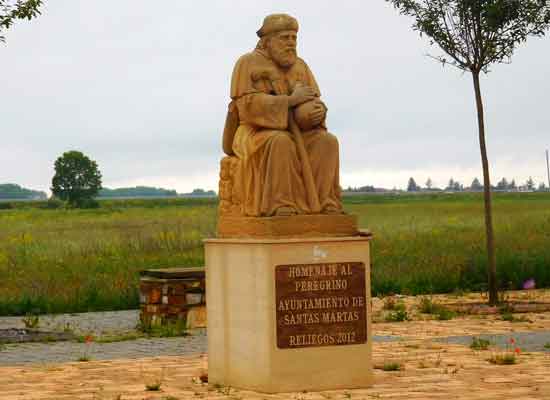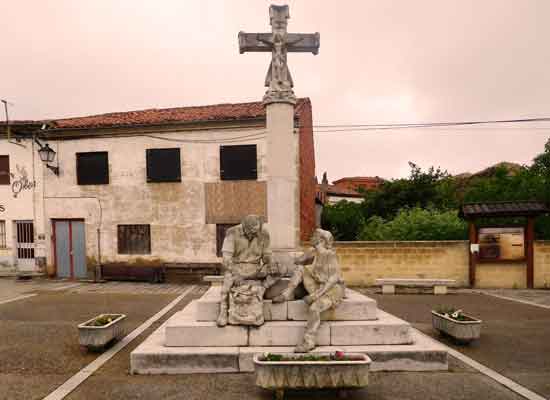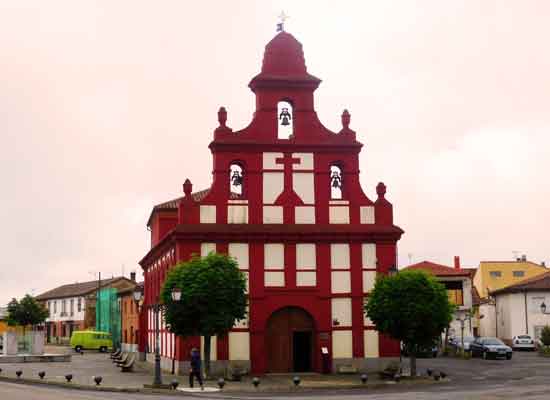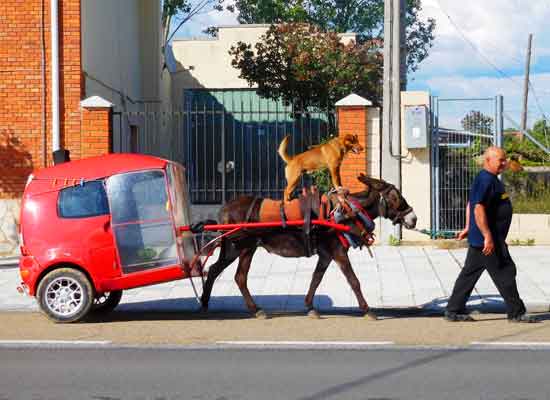Step by Step on The Way of Saint James
From El Burgo Ranero to Puente Villarente
29 May 2018
Stage 19 – 25 km

The friends who will be heading to León today, covering forty kilometres in one go, have entrusted a courier with transporting their backpacks to the destination. This way, walking without any weight on their shoulders, they can move more easily and maintain a faster pace.
Even Dante sends his “beloved” trolley, which he has dragged along for eighteen days with sheer arm strength.
We all leave the hostel together at 5:40.
After bidding farewell to Dante and the Tuscans, who head off light and swift, Rocco and I set off more slowly. After walking just a few steps, we meet Giovanna outside the hostel where she spent the night. She is in despair and crying because of the blisters on her feet, which cause her so much pain that they prevent her from walking. She tells us that she will take a train to León this very morning and, once there, she will go to the hospital for treatment.
Once again, I am reminded of the “fluidity” of the groups that form along The Way of Saint James and how they are constantly changing. Of the large group of people we dined with last night, only two of us remain this morning: for one reason or another, everyone else is heading straight to León today. Rocco and I, however, will cover just nineteen kilometres and finish our stage in Puente Villarente.
After El Burgo Ranero, the first village we encounter is Reliegos. The two towns are separated by a full thirteen kilometres, which means that the initial stretch of today’s journey will once again be an endless march through emptiness. Along the entire French Way, this is the second longest distance between two towns, following the seventeen kilometres we covered two days ago.
The landscape we pass through is still that typical of the “mesetas”: flat, bare, and without tall vegetation. Only occasionally, along the roadside, do we spot a sparse group of little trees, lined up like soldiers at attention, as if saluting us and honouring our “commitment” to completing the challenge. The temperature this morning is not excessively cold. The sky’s milky-white hue does not reveal its intentions. – Will we get rain again today? – As the saying goes, we will find out by living through it.
After a night’s rest, I once again feel as though the physical problems that have been troubling me for a few days have disappeared. However, I am careful not to think I am healed and wait until I have covered a good number of kilometres before declaring victory. Potassium and magnesium tablets, along with anti-inflammatories, are the medications I take regularly to treat the pain in my shins.
Speaking of therapeutic matters, I take this opportunity to point out to the reader of this account that I am not a doctor and that my descriptions of the treatments I use are not based on any scientific foundation. There is no guarantee that the information I share is correct, and even if it were, there is no certainty that the treatment would be suitable for anyone with similar symptoms. Consulting a specialist is always recommended. In my case, I have relied on advice received—sometimes even by phone—from people more or less knowledgeable on the subject. I must confess that I also sought the opinion of “Dr.” Google to form an idea. Seeing a doctor would require a break—possibly a long one—from The Way. As long as I can keep going, I prefer to endure and let nature take its course, perhaps giving it a little help with the remedies I’m using, hoping they are the right ones.
***
Accompanied by the same solitude that has followed us in recent days, we cover the long, flat stretch to Reliegos in nearly four hours. After such a long walk through the countryside, the small village appears as a sleepy place, where not a soul can be seen.
In the past, Reliegos was famous throughout Spain for producing excellent tomatoes. Moreover, the village gained attention when, on 28 December 1947, a meteorite fell on Calle Real, creating a loud noise that frightened the farmers working nearby. It was the last meteorite recorded in Spain and is now displayed at the National Museum of Sciences in Madrid.


We do not stop in Reliegos; we simply pass through and continue walking for another hour and a half until we reach Mansilla de las Mulas. As we enter the town, we see a stone monument depicting three exhausted pilgrims resting on a square, stepped base. From the centre of the base rises a cross with images of the Virgin and Christ.
The site of the monument marks the point where an alternative route, offered to travellers a few kilometres after Sahagún, rejoins the French Way. Nearby stands the sanctuary dedicated to the town’s patron saint, the Virgen de la Gracia. The outer walls of the religious building feature wide, vertical, dark red bands painted on an ochre background—a rather unusual characteristic for a church, at least among those seen along The Way.
In the town centre, unlike most of the villages we’ve passed through so far, we find a fair amount of activity. In the small Plaza del Pozo, there’s a colourful fruit and vegetable market with several stalls surrounded by many locals. Some parts of the square’s perimeter feature two-story houses built in the typical Castilian style. We take a moment to browse the stalls and, after so much solitude, enjoy being among people again.
Several sections of Mansilla de las Mulas preserve large portions of walls, various crenellated towers, and even one of the four original gates to the old village—remnants of one of the best-preserved medieval fortifications in the province of León.
Around midday, we leave Mansilla de las Mulas.
As we exit the town, before crossing the bridge over the Río Esla, we get one last wide view of the crenellated walls that once surrounded the ancient settlement.
We continue along a dirt path that runs parallel to the main road.
The constant passage of motor vehicles proves to be an irritating accompaniment for nearly six kilometres, bringing us to the end of today’s stage.
It also starts to drizzle, but it doesn’t last long and, as usual, it stops just after we put on our ponchos.
The sky remains overcast, and there’s no guarantee there won’t be another downpour, so it’s better to stay protected.
During the last two kilometres, the pain in my shins flares up again, making this final stretch of The Way for today particularly agonising.
Without stopping, we pass through Villamoros de Mansilla and shortly afterward arrive in Puente Villarente.
As we enter the village, we cross the Río Porma via a modern wooden footbridge, built recently for pedestrians. Meanwhile, the parallel main road crosses the river over one of the oldest bridges in the province of León.
Walking alongside it rather than over it allows us to admire the structure’s stone arches—twenty in total. The bridge’s origins date back to Roman times, although almost nothing remains from that period due to various reconstructions starting in the 16th century.
At 13:30, we stop at the Albergue El Delfín Verde.
The hostel is part of a larger complex that also includes a restaurant and a hotel with a swimming pool.
Naturally, we opt for the simpler section of the facility, where pilgrims sleep in shared dormitories with bunk beds.
The basic accommodation matches the modest price of just 5 Euros.
Taking off my shoes, I notice that the two small blisters I developed a few days ago are swollen and slightly itchy again.
I pierce them with a needle to drain the fluid and then apply some antibiotic ointment.
Since the blisters are quite small, I decide, as before, not to thread cotton through them to aid drainage.
In the afternoon, taking advantage of the pleasant sunshine, we settle in the small courtyard in front of the hostel to relax and chat with other pilgrims.
Among them is Juaní, our cheerful Spanish friend, who has been walking with Anna, a French teacher, since leaving Salvador behind due to his ankle tendonitis.
Both petite and fast-paced, they make a good team, keeping the same rhythm as they walk.
Puente Villarente is a rather unremarkable village—essentially just a cluster of houses and service stations.
The only monument of any real interest, which also gives the town its name, is the bridge we saw upon arrival.
Nevertheless, as is our habit, we take a walk to the centre. Despite the lack of any major sights, the visit turns out to be surprisingly interesting.

After meeting many travellers along The Way, here we encounter one who is truly unique.
This pilgrim appears to be in his seventies. He moves at a leisurely pace, holding the reins of a mule that follows him step by step. On the mule’s back stands a medium-sized dog, steady on all fours, gazing forward as if expecting to discover America at any moment and shout, “Land! Land!”
Instead of pulling a cart, the mule is harnessed to the back half of a “minicar,” which has been cut and adapted for this purpose, complete with side bars for attaching it to the animal.
I find the scene hilarious, but what amuses me most is the dog, confidently perched atop the mule, overseeing the situation from above.
We continue our brief tour of the centre without uncovering anything else of interest.
A little later, as we head back to the hostel, we spot the same amusing characters again.
This time they are stopped in an open space next to the main road. The scene has changed: the mule is free from its harness and stands motionless, dozing to recover from the day’s efforts; the pilgrim is busy arranging his belongings; the detached minicar is parked in a corner; and the dog is happily running around the area.
Unable to resist, I go over to meet the unusual pilgrim.
Ginés López Marín—that’s his name—tells me he started his journey in Santurce, in the Basque Country.
He has already been to Santiago de Compostela and is now on his way back, which explains why we saw him walking in the opposite direction to most pilgrims.
The half-minicar, which he modified himself, serves as his shelter and contains everything he needs to be self-sufficient during his travels.
Here in Puente Villarente, he has stopped in this open area in the town centre to spend the night.
Day after day, he chooses where to stop without relying on hostels.
Ginés is somewhat upset because some people have accused him of mistreating his animals. In reality, he has cared for both the mule, Marina, and the dog, Comotú, since they were born.
He bottle-fed Marina when she was orphaned, and he rescued Comotú from a shelter, saving him from certain death.
Before saying goodbye and wishing each other “Buen Camino!”, Ginés tells me that next year he plans to make a pilgrimage to Rome in the same manner, with his final destination being St. Peter’s Square.
To end the day, we dine at the restaurant next to the hostel. I order a seafood salad, which is nothing special, followed by sea bass and a dessert with hazelnut cream.
I have now covered more than half the total distance of The Way of Saint James. Reaching this point, I feel I can roughly estimate how much longer it will take to arrive in Finisterre—physical setbacks permitting.
So, before going to bed, I decide to book my return flight to Italy online. I reserve a direct flight from Porto, Portugal, to Naples on 17 June.
| © Aldo Lardizzone 2020 |  |
CREATIVE COMMONS |



